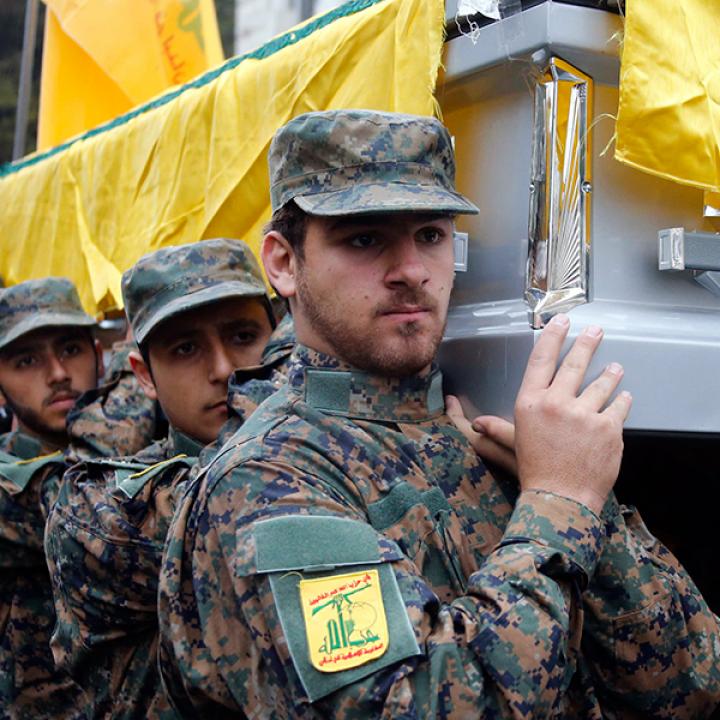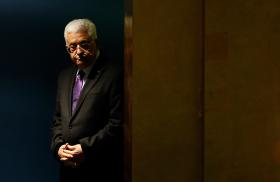
- Policy Analysis
- PolicyWatch 2566
Hezbollah Fatalities in the Syrian War

Analysis of funeral reports and other open-source data offers potentially revealing insights into the militia's combat losses in Syria, its shifting role in the war next door, and the security of its position back home in Lebanon.
Lebanese Hezbollah's entire raison d'etre is founded on the doctrine of al-Muqawama, or resistance against Israel. Since at least 2012, however, the Shiite militia has fought fellow Arabs in neighboring Syria on Iran's behalf, in an attempt to secure the survival of Bashar al-Assad's regime and thereby maintain its own overland lifeline to Tehran. Unsurprisingly, this awkward conflict between theory and practice has resulted in contradictory statements from Hezbollah's leadership concerning the extent of the group's presence and participation in the war next door. During the conflict's early years, they dismissed all such claims as enemy propaganda, yet they have acknowledged and even boasted of their involvement as the war drags on.
Hezbollah's funeral announcements, in particular those appearing on www.southlebanon.org, and www.yasour.org, provide useful insight into the actual nature and extent of the group's participation in combat. Comparing this data with Persian-language open-source material regarding fatalities among Iran's Islamic Revolutionary Guard Corps (IRGC) also illuminates an apparent shift in how Tehran views Hezbollah's role in the war.
WHAT THE FUNERAL DATA TELLS US
According to the above sources, at least 865 Hezbollah fighters were killed in combat in Syria between September 30, 2012, and February 16, 2016. Since the group's leadership has every reason to downplay losses, this figure must serve as an absolute minimum number killed -- the actual toll is likely higher. Indeed, over the same time period, these sources reported a seemingly high number of young Lebanese males dying from traffic accidents or sudden heart failure; such announcements could be an attempt to hide the real number of Hezbollah fatalities, though neither this conclusion nor the veracity of the traffic/cardiac death tolls can be established with certainty.
The sources further identify 49 of the deceased as "al-Qaid al-Shahid" (martyred leader/commander) or "al-Qaid al-Maydani" (field leader/commander). This indicates they served as commanding officers, distinguishing them from rank-and-file fatalities.
The open-source material is extremely secretive about where exactly these fighters died in Syria; of the 865 known fatalities, place of death was disclosed for only 32. And in several cases, this information was extracted from Persian-language material rather than Lebanese sources.
The data also shows several fatality peaks: May 2013 (88 fighters killed), July 2014 (36), February 2015 (34), and a relatively high average of 36 fatalities per month from May 2015 to January 2016. The December 2013 peak shown in figure 1 is misleading because the sources announced nearly a hundred fatalities all at once, even though the actual month of death/burial for many of them occurred earlier.
Figure 1. Hezbollah and IRGC Combat Fatalities in Syria
These fatality spikes might also indicate place of death for fighters even when that information is not openly disclosed, since the peaks in funerals tend to coincide with major battles in Syria:
- In May 2013, Hezbollah and the Syrian army launched a joint offensive against the city of al-Qusayr, strategically located between Damascus and the Mediterranean coast and close to the Lebanese border.
- Although there is no record of Hezbollah operations in July 2014, the increased fatalities that month coincided with the Islamic State's seizure of the Shaer gas field in Homs governorate on July 17, and its capture of the 17th Army Division's base near Raqqa on July 25.
- The February 2015 fatalities likely reflect the joint offensive by the rebel Free Syrian Army and al-Qaeda affiliate Jabhat al-Nusra against Hezbollah strongholds in western Qalamoun, near the Lebanese border.
- The high monthly fatality rate in the last half of 2015 includes the battle for Zabadani last July; it also marks the run-up to and aftermath of the first Russian air campaign in Syria, which began in late September 2015 and ushered in a period of increased offensives by regime forces and their allies.
HEZBOLLAH LOSSES VS. IRGC LOSSES
The fluctuations in Hezbollah and IRGC fatality rates appear to reflect the Islamic Republic's shifting tactical considerations in Syria. Initially, Tehran preferred to have Hezbollah play the direct combat role in Syria rather deploying large-scale IRGC forces there, which could have provoked other external actors to follow Iran's example. This resulted in large Hezbollah fatality rates and very few IRGC fatalities.
Eventually, however, increased Hezbollah fatalities in Syria threatened to upset the military balance in Lebanon and even tempt outsiders to exploit Hezbollah's preoccupation abroad in order to teach the group a lesson back home. As a result, the IRGC apparently began deploying many more of its own troops to Syria, as reflected by the sharp decrease in Hezbollah fatalities and the simultaneous sharp increase in IRGC fatalities after September 2015. Not coincidentally, this was also when the Russian air campaign began -- all of which suggests that there are limits to how much Hezbollah can do in Syria to advance Tehran's objectives.
WHERE DID THESE SLAIN FIGHTERS COME FROM?
Despite Hezbollah's secretiveness regarding many aspects of its Syria deployment and fatalities, its funeral announcements provide detailed information about the native governorate, district, and village of origin for most of the fighters killed in combat. That information in turn provides limited but valuable insights into the militia's recruitment base in Lebanon and force composition in Syria.
Of the 865 fighters reportedly killed, 682 hailed from the Nabatiyah, Beqaa, and South governorates. No governorate was indicated for 136 fighters; 10 others originated from villages on the Syrian side of the border, while the remainder were born in the Mount Lebanon, Beirut, and North governorates.
Figure 2. Total Hezbollah Combat Fatalities by Native Governorate
Lebanon lacks an official census, so it is impossible to analyze these numbers relative to the total populations or Shiite composition of each governorate. In general, however, most of Hezbollah's combat fatalities seem to have originated from Shiite-majority governorates and subdistricts. Several districts showed particularly high rates: Baalbek (158 fatalities) and Hermel (43) in Beqaa governorate; Bint Jbail (79), Marjeyoun (52), and Nabatiyah (122) in Nabatiyah governorate; and Sidon (37) and Tyre (137) in the South governorate. (Note that for the purposes of this study, Beirut governorate, which is not subdivided, counts as both a governorate and a district.)
Figure 3. Hezbollah Combat Fatalities by Native District, January 2012-February 2016
A further breakdown of the data shows that some districts had a mixed pattern of city dwellers and village dwellers killed in combat:
- In Baalbek district, 44 of the 158 fatalities were natives of Baalbek City, 13 were from Brital, 9 from al-Khraibe, 8 from Younine, and 6 from al-Bozalieh. The remaining 78 were recruited from 36 distinct villages.
- In Hermel district, the majority of the 43 combat fatalities were city dwellers: 23 were from Hermel City, 14 from al-Nabi Shayth, and the remainder from al-Qasr and Zita.
In other districts, however, most slain Hezbollah fighters hailed from the countryside, with fatalities more or less evenly distributed among various villages and smaller towns:
- In Bint Jbail district (79 fatalities), Aita al-Shab (12) and Beit Lif (11) suffered the most losses. Bint Jbail City lost 7 fighters, while the remaining 49 fatalities originated from 19 distinct villages.
- In Marjeyoun district (52), Majdel Selm (10) and Meis al-Jabal (10) suffered the most losses; the remaining 32 fatalities hailed from 7 other villages.
- In Nabatiyah district (122), Nabatiyah City suffered 14 combat fatalities; the remaining 108 were distributed among 42 villages.
- In Sidon district (37), only 3 originated from Sidon City itself; the remainder were distributed among 16 villages.
- In Tyre (137) too, only 5 originated from Tyre City, while the remainder came from 42 distinct towns and villages. Only Shahabia (12) and Majdel Zoun (10) suffered double-digit fatalities.
The data therefore provides some indication of Hezbollah's force structure. The wide distribution in place of origin for fighters killed during any given period (including the peak periods discussed above) indicates a mixed force composition. This stands in contrast to the provincial force structure of the IRGC, in which entire units are often composed of personnel from the same area.
Figure 4. Monthly Hezbollah Combat Fatalities by Native Governorate
Again, lack of official, reliable information about Lebanon's demography prevents firm conclusions regarding the impact that these combat fatalities might have on Hezbollah's ability to defend its positions back at home against adversaries. However, to the extent that its losses are more or less evenly distributed among rural villages and small towns, with few communities suffering double-digit losses, then the militia may have preserved its manpower base.
Ali Alfoneh is the author of Iran Unveiled: How the Revolutionary Guards Is Turning Theocracy into Military Dictatorship (AEI Press, 2013).



